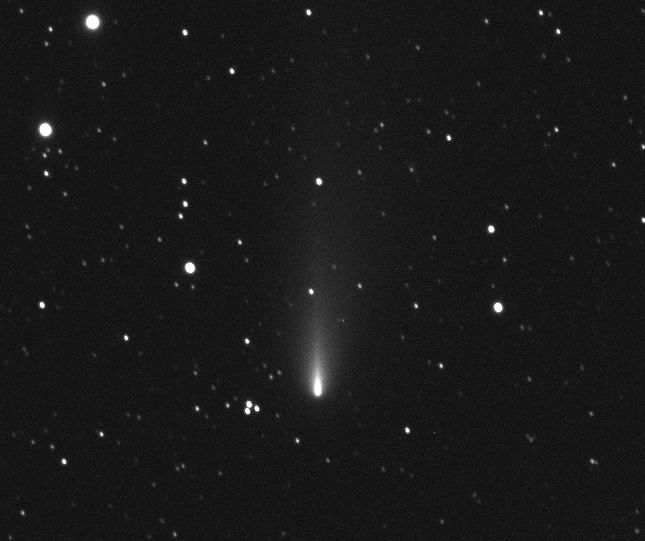
This image of comet C/1999 S4 (LINEAR) was taken on July 2 as the comet gradually brightened. Maximum brightness was predicted to occur on July 23 as the comet passed close to the earth and sun. This image captured an early look at the comet as it moved from Andromeda into Perseus. Observers estimated that the comet was about magnitude 8.5 with a tail about 8 arcminutes long. At this time, the comet was a morning object for midnorthern latitudes, rising around midnight and climbing to about 30 deg. above the northeastern horizon by the beginning of twilight. This comet was not visible to the naked eye, even from a dark sky location. However, I also observed it in a friend's 18-inch f4.5 Dobsonian telescope while the CCD was taking this image, and the visual sight was very nice.
This comet was discovered by the Lincoln Laboratory Near Earth Asteroid Research project. Although they are actually looking for asteroids, that automated minor-planet survey discovers quite a few comets as a by-product of the search for asteroids. The comet was nearly as far out in the solar system as the orbit of Jupiter when it was discovered last September. It will pass 114 million kilometers from the sun, and come as close as 56 million kilometers to earth when it nears perihelion later this month. Although the comet was expected to peak around July 23, it appeared to break up and fade rapidly. In August, the comet quickly disappeared for northern hemisphere observers, so I was glad to catch the comet while I could.
Comets are essentially dirty snow-balls, and are believed to contain material left over from the formation of the solar system. Comets spend most of their time far from the inner solar system in a region beyond the plant Pluto known as the Oort Cloud, orbiting at a distance of about half a light year from the Sun. When a comet is out in the Oort Cloud, it is much too far away to be seen from Earth. Comets are only discovered when the comet's orbit brings it into the inner solar system. When that happens, the heat from the Sun causes outer frozen layers of the comet to "melt" or sublimate, and the comet grows a tail. In this photo, you can see comet's tail exrtending away from the sun. The comet was actually moving to the left in this image, not straight down as one might assume from the direction of the tail. The orbit for this comet suggests that this is perhaps its first trip through the inner solar system.
1.3 million years from now a star (known as Gliese 710) will pass close enough to our solar system to disturb the Oort Cloud, possibly triggering a downpour of comets earthward. Nevertheless, the deluge of comets driven toward our planet by such a disturbance will still take another several hundred thousand years to reach the inner solar system. One can only imagine how beautiful it would be to witness a significant number of naked eye comets visiting the inner solar system at the same time. Of course, a cloudburst of comets raining in toward the Sun increases the danger of a comet crossing Earth's orbit. If a large comet impacted planet Earth, it could cause mass extinctions.
This is an unguided 60 second exposure CCD image taken with an ST-8E using a 5 inch Takahashi FS-128 refractor telescope at prime focus operating at f8. The image was taken at Windowpane Observatory's primary Northern Arizona observing location near Prescott. Special thanks to Bill Georgevich for his assistance and hospitality during my observing night.
Constellation: Andromeda
RA: 02h 37m Dec: +43d 36'
July 2, 2000 at 1024 U.T.
Image by Sid Leach
Prescott, Arizona
Recent Images.
Complete list of images.
Description of equipment used to acquire images.
Home
Feedback and comments should go to Sid